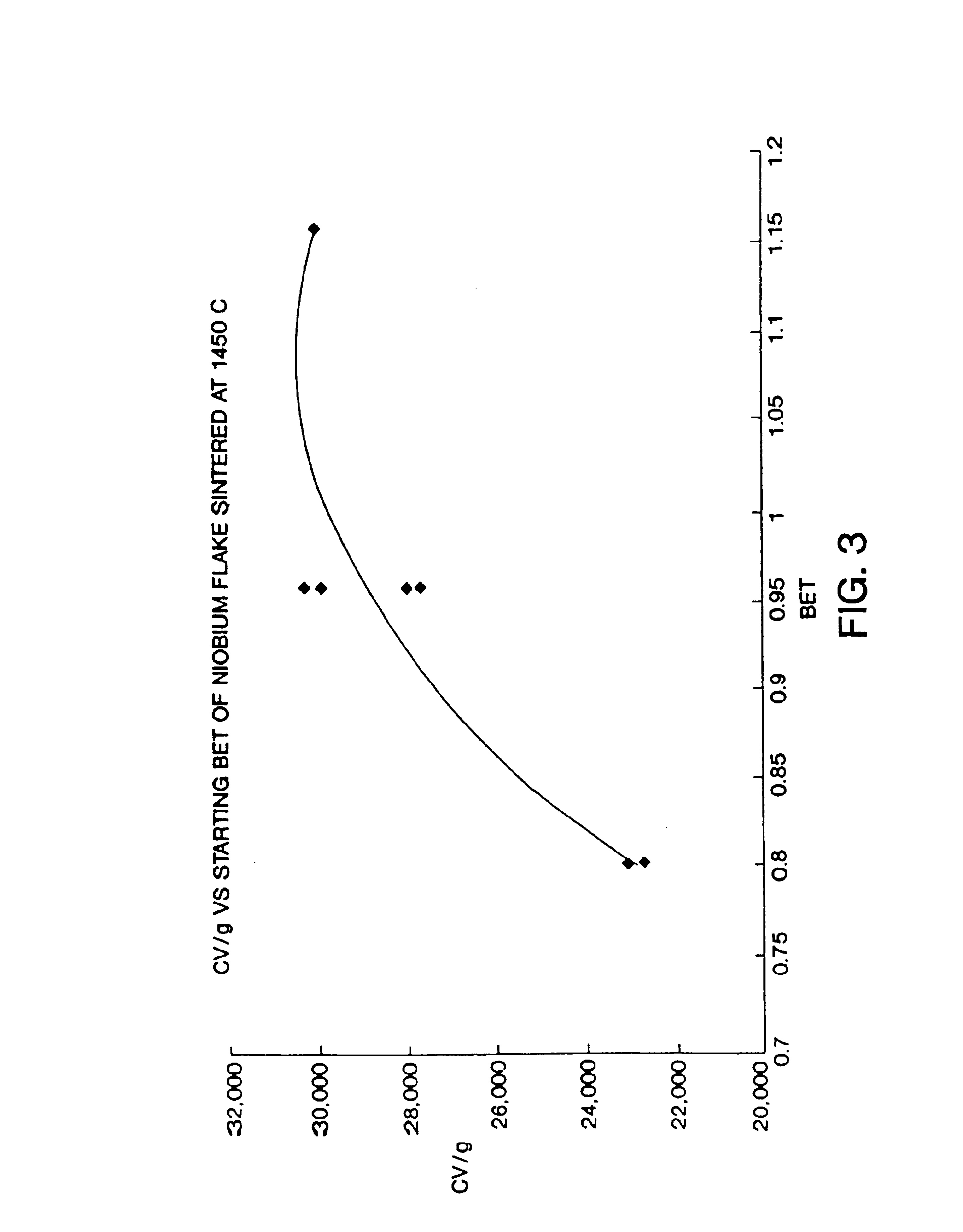Nitrided niobium powders and niobium electrolytic capacitors
- Summary
- Abstract
- Description
- Claims
- Application Information
AI Technical Summary
Benefits of technology
Problems solved by technology
Method used
Image
Examples
example 1
[0094]This example illustrates an embodiment of this invention comprising angular niobium powder. Electron beam produced niobium ingot was hydrided by heating the ingot in a vacuum of 10−4 torr to 850° C. for 120 minutes. The vacuum was replaced by hydrogen gas purge at 21 kPa for sufficient time to embrittle the ingot. The vacuum was then pumped down to −28″ mercury and then backfilled with argon to −5″ Hg. The pressure was maintained until the temperature, as measured by a work thermocouple, stabilized. Air was gradually introduced in increasing pressure such that the work temperature did not rise. The embrittled ingot was crushed into angular powder in a jaw crusher and classified by extracting powder which passed through a No. 325 sieve screen (equivalent to a 44 micrometer particle size). Hydrogen was removed from the size-reduced hydrogen-containing particles by heating the particles to 850° C. in a vacuum until pressure was no longer affected by hydrogen being emitted from th...
example 2
[0095]This example illustrates an embodiment of the powder of this invention comprising agglomerated mixture of angular and flaked powder. 2.5 lbs of degassed angular powder prepared essentially in the manner of Example 1 was processed in a 1-S Union Process attritor stirred ball mill (285 rpm for 90 minutes) where powder dispersed in 2,400 ml ethanol medium and 40 lbs {fraction (3 / 16)}″ 440SS medium was formed into flaked powder by the impact of stainless steel balls moved by the action of rotating bars. After the desired deformation into flake, the niobium powder was then removed and washed to remove any alcohol present. The niobium powder was then washed with a mixture of deionized water, hydrofluoric acid and hydrochloric acid in an amount of 500 ml / lb, 4 ml / lb and 250 ml / lb of niobium respectively (18.6% HCl containing 22 ml / kg HF) to remove metal contamination (e.g. iron, nickel, chromium and the like transferred from contact with stainless steel balls). Afterwards, the niobiu...
example 3
[0096]This example illustrates an embodiment of the powder of this invention comprising agglomerated flaked powder. Acid leached flaked powder having an aspect ratio of about 50 to 70 was prepared essentially as described in Example 2 (cycle time of 60 minutes) except the niobium powder was hydrided a second time by exposure to hydrogen at 20.7 kPa (3 psig) and 850° C. to provide an embrittled flake which was cooled and reduced in size by self impaction in a fluidized bed Jet mill (obtained from Hosokawa Micron Powder Systems, Summit, N.J.) to make flaked powder having a median particle size of 6 micrometers (as determined by laser particle size scanning). The pre-agglomerated BET surface area was 0.62 m2 / g. The reduced-size size flaked powder was agglomerated by heating in a hydrogen atmosphere by heating the furnace at a rate of 10° C. / minute to 1050° C. under a vacuum furnace and holding this temperature until the furnace pressure decreased below 100 microns. Tantalum coarse chip...
PUM
| Property | Measurement | Unit |
|---|---|---|
| Temperature | aaaaa | aaaaa |
| Temperature | aaaaa | aaaaa |
| Fraction | aaaaa | aaaaa |
Abstract
Description
Claims
Application Information
 Login to View More
Login to View More - R&D
- Intellectual Property
- Life Sciences
- Materials
- Tech Scout
- Unparalleled Data Quality
- Higher Quality Content
- 60% Fewer Hallucinations
Browse by: Latest US Patents, China's latest patents, Technical Efficacy Thesaurus, Application Domain, Technology Topic, Popular Technical Reports.
© 2025 PatSnap. All rights reserved.Legal|Privacy policy|Modern Slavery Act Transparency Statement|Sitemap|About US| Contact US: help@patsnap.com



